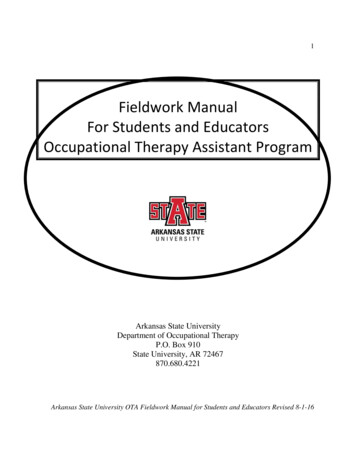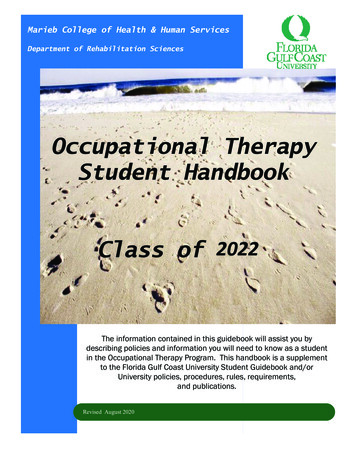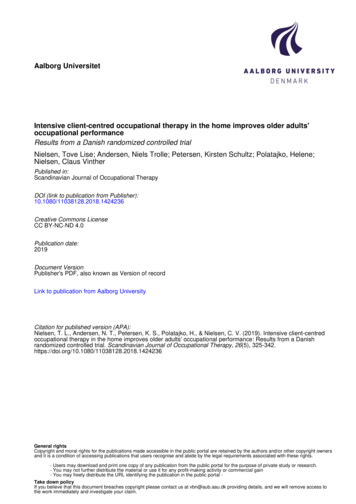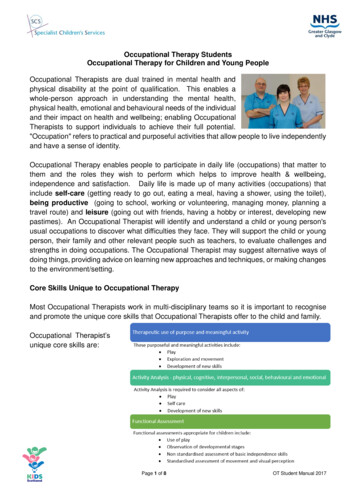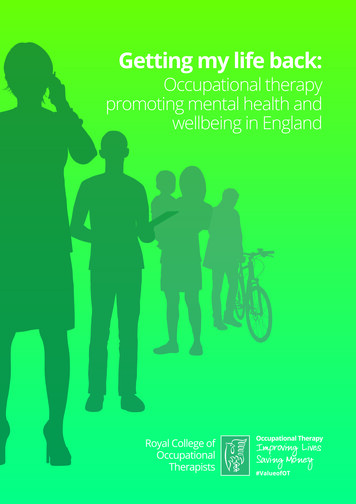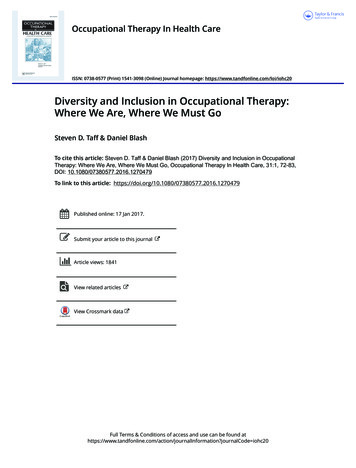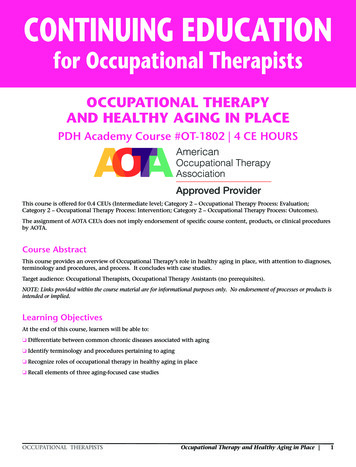
Transcription
CONTINUING EDUCATIONfor Occupational TherapistsOCCUPATIONAL THERAPYAND HEALTHY AGING IN PLACEPDH Academy Course #OT-1802 4 CE HOURSThis course is offered for 0.4 CEUs (Intermediate level; Category 2 – Occupational Therapy Process: Evaluation;Category 2 – Occupational Therapy Process: Intervention; Category 2 – Occupational Therapy Process: Outcomes).The assignment of AOTA CEUs does not imply endorsement of specific course content, products, or clinical proceduresby AOTA.Course AbstractThis course provides an overview of Occupational Therapy’s role in healthy aging in place, with attention to diagnoses,terminology and procedures, and process. It concludes with case studies.Target audience: Occupational Therapists, Occupational Therapy Assistants (no prerequisites).NOTE: Links provided within the course material are for informational purposes only. No endorsement of processes or products isintended or implied.Learning ObjectivesAt the end of this course, learners will be able to: Differentiate between common chronic diseases associated with aging Identify terminology and procedures pertaining to aging Recognize roles of occupational therapy in healthy aging in place Recall elements of three aging-focused case studiesOCCUPATIONAL THERAPISTSOccupational Therapy and Healthy Aging in Place 1
Timed Topic OutlineI. Common Chronic Diseases Associated with Aging (90 minutes)Type 2 Diabetes Mellitus (DMII), Arthritis, Dementia / Alzheimer’s, UrinaryTract Infection (UTI) and Sepsis, Respiratory Disorders, Cardiovascular Disease,Low Vision, Osteoporosis, Mental / Behavioral HealthII. Common Terminology (10 minutes)III. Role of Occupational Therapy in Healthy Aging in Place (45 minutes)Overview, Settings, Areas Addressed, ProcessIV. Case Studies (75 minutes)V. Conclusion, Additional Resources, References, and Exam (20 minutes)Delivery & Instructional MethodDistance Learning – Independent. Correspondence/internet text-basedself-study, including a provider-graded multiple choice final exam. To earncontinuing education credit for this course, you must achieve a passing score of 80%on the final exam.Registration & CancellationVisit www.pdhtherapy.com to register for online courses and/or requestcorrespondence courses.As PDH Academy offers self-study courses only, provider cancellations dueto inclement weather, instructor no-shows, and/or insufficient enrollmentare not concerns. In the unlikely event that a self-study course is temporarilyunavailable, already-enrolled participants will be notified by email. Anotification will also be posted on the relevant pages of our website.Customers who cancel orders within five business days of the order date receivea full refund. Cancellations can be made by phone at (888)564-9098 or email atsupport@pdhacademy.com.Accessibility and/orSpecial Needs Concerns?Contact Customer Service by phone at (888)564-9098 or email atsupport@pdhacademy.com.Course Author Bio & DisclosureMidge (Annamaria) Hobbs, OTR/L, originally from the UK, graduated with an MAin Occupational Therapy from Tufts University, Boston MA in 2005. She spentthe following ten years working in long-term acute care gaining experience as aclinician, educator, and manager. In 2010, Midge was selected for the inauguralcohort of AOTA’s Emerging Leaders Development Program (ELDP). Since then shehas continued to amplify AOTA’s leadership initiatives by serving the EmergingLeaders Development Committee (ELDC) as Chairperson and as a member ofAOTA’s Volunteer Leadership Development Committee (VLDC). She is currentlythe Editor of AOTA’s A Mindful Path to Leadership, a new online self-pacedleadership development course, and she co-authored Module 3: Mentoring andLeadership with current AOTA president, Amy Lamb.Midge is currently employed as a consultant for internship development inthe adolescent residential psychiatric programs at Sheppard Pratt Hospital inBaltimore MD, an adjunct professor at the MGH Institute of Health Professionsin Boston, and a clinician at local rehab and assisted living facilities. Midge isalso enrolled at Thomas Jefferson University for her post-professional OTD witha specialty in teaching in the digital age. In her limited spare time she watchesEnglish soccer and eats a lot of popcorn.DISCLOSURES: Financial – Midge (Annamaria) Hobbs received a stipend as theauthor of this course. Nonfinancial – No relevant nonfinancial relationship exists.2 Occupational Therapy and Healthy Aging in PlaceINTRODUCTIONAccording to the Centers for DiseaseControl and Prevention (CDC),aging in place is defined as “theability to live in one’s own homeand community, independentlyand comfortably, regardless of age,income or ability level.”1 The AARPhas determined that at least 90%of individuals over 65 would preferto age in place – to remain in theirown homes as they age, ratherthan relocating to senior housingfacilities or nursing homes.2 Whileescalating costs are a factor, there isalso a general sense of dissatisfactionamong older Americans regardingthe trajectory and quality oflong-term care; further, researchindicates that health and wellbeingdeteriorates with each change ofenvironment.3Despite the preference to remainat home, there are significantchallenges associated with successfulaging in place. In addition tofinancial concerns, many olderadults experience chronic disease,an increase risk of falls, and mentalhealth concerns as they age.The National Council on Aging(NCOA) reports that approximately92% of older adults have beendiagnosed with at least onechronic condition, with diabetes,heart disease, cancer and strokecontributing to two thirds ofdeaths among older adults eachyear. Falls are the leading cause oftrauma-related injuries and hospitaladmissions among seniors. TheUnited States spends approximately 30 billion a year in treatinginjuries associated with falls. Onein four older adults is also said toexperience mental health challenges,including depression and anxietydisorders, although the majority donot seek help or receive treatment.Additionally, the number of olderadults with substance abuse concernscontinues to increase annually.Whether undiagnosed or untreated,mental health and substance abusechallenges contribute to poorerhealth outcomes, higher medicalcare needs, increased caregiverburden, and a decline in quality ofOCCUPATIONAL THERAPISTS
life with a higher mortality rate and suicide risk.4 Thesehealth related challenges, combined with fear of losingtheir independence, often leads to hesitancy aroundasking for help, which may lead to greater isolation,increased safety concerns, and a further decline inhealth and wellbeing.2Clearly, a gap exists between the goal of livingindependently at home and making aging inplace both a reality and a success. Therefore, everyconsideration must be made to review each individualcase to ensure safety and minimize discomfort,injury, and possible fatality. This need not be asignificant expense or inconvenience, but it doesrequire collaboration, education, and adaptation,and frequently necessitates some environmentalremodeling to accommodate changes in health andfunctional ability.Occupational Therapy (OT), with its distinct focuson evaluating individual needs and developingmeaningful, client-centered interventions, can helpindividual maximize functional capacity througheducation, the improvement of strength and activitytolerance, psychosocial support, and environmentaladaptations. While some occupational therapistsbecome Certified Aging in Place Specialists (CAPS),it is important that all therapists, regardless of theirprimary practice area, recognize that they can playa key role in successful aging in place with thegoal of enhancing quality of life within the homeenvironment by allowing older adults to continueparticipating in meaningful activities and byfacilitating the necessary modifications to ensuresafety.COMMON CHRONIC DISEASESASSOCIATED WITH AGINGType 2 Diabetes Mellitus (DMII)Description: Diabetes is a chronic condition thataffects the way the body manages blood sugar orglucose levels. In Type 2 diabetes, the hormonethat regulates glucose levels, insulin, is not madeor used appropriately by the body. This leads tohyperglycemia, a buildup of glucose in thebloodstream. Over time, chronic high glucose levelscan have significant health complications includingperipheral neuropathy, cardiovascular problems, andvision impairments.5Pathophysiology: Type 2 diabetes mellitus, alsoknown as insulin resistance, typically develops inadults and prevalence increases with age. Up to athird of individuals over the age of 65 experienceimpaired glucose tolerance and are diagnosed with thedisease, while it is estimated that approximately 1 in 4individuals go undiagnosed. While the disease affectsall races, in the United States, the populations mostOCCUPATIONAL THERAPISTSimpacted are Native Americans, Hispanic-Americans,and Asian-Americans.6 An estimated 245 billion isspent on medical costs each year in the United States;according to the CDC, risk of death is 50% higher forthose diagnosed with the disease than those without.In 2015, approximately 1.6 million deaths wereattributed to diabetes; the World Health Organization(WHO) projects that this number will continue to growand by 2030 diabetes will be the seventh leading causeof death in the U.S.5 7In Type 2 diabetes, the normal processing of glucose– the main source of energy for the body’s cells –begins to fail. Instead of moving into the cells, glucosebuilds up in the bloodstream, and as levels increasethe insulin-producing beta cells in the pancreasrespond by releasing more insulin. Eventually, thebeta cells become impaired and can no longer meetthe body’s demands. Pathogenesis of diabetes mellitusis considered complex, but genetic predispositionis known to play a role along with a cluster of riskfactors, including obesity, inactivity, and diet, whichtypically precede and predict onset. In addition, certainhormonal diseases such as Cushing’s syndrome maylead to insulin resistance and diabetes.5 8Clinical picture: Prediabetes is a condition definedby higher than normal levels of glucose in thebloodstream but not high enough to be classified asdiabetes. However, if left untreated prediabetes oftendevelops into Type 2 diabetes. Symptoms of diabetestypically develop slowly and mild hyperglycemia isoften asymptomatic, which may result in delayeddiagnosis. Typical symptoms include polydipsia andpolyuria as excess glucose levels in the bloodstreamcause fluid to be drawn from the tissues. This may leadto dehydration and excess thirst causing weakness,fatigue, mental status changes, and orthostatichypotension. Additionally, when excessive caloriesare lost through the urine, individuals with diabetesmay lose weight and often experience an increase inhunger.5Diagnosis includes a glycated hemoglobin (AC1)test to determine the average blood glucose level forapproximately 2-3 months.ResultAC1Normal 5.7%Prediabetes5.7% to 6.4%Diabetes6.5% or higherAmerican Diabetes Association9If the AC1 test is not available, doctors may performrandom or fasting blood sugar tests, or an oral glucosetolerance test. Once diagnosed, a physician willrecommend an AC1 target range depending on age andother individual factors, but the American DiabetesAssociation suggests that AC1 levels should be checkedOccupational Therapy and Healthy Aging in Place 3
between two and four times a year to assess treatmentprogress. A medical professional will also periodicallycheck cholesterol levels, thyroid, liver, and kidneyfunctions, and blood pressure, as well as recommendregular eye and foot exams.9 10There are many complications associated with diabetes,particularly if the disease is not managed well, whichcan lead to a number of significant health problems.Diabetes can affect the body’s ability to heal, leadingto frequent infections or non-healing skin problems.Individuals with diabetes are also 40% more likelyto develop eye problems such as glaucoma andcataracts. Approximately half of all those diagnosedwith diabetes also experience nerve damage in theform of peripheral neuropathy. Symptoms includenumbness, tingling, pain, and/or loss of sensation.Injury is commonplace as well as skin changes dueto poor circulation, which may lead to narrowingand hardening of the peripheral blood vessels. Formany, reduced blood flow evolves into peripheralarterial disease (PAD) that may further increase therisk of skin infections, which may in turn lead toamputation. People with diabetes are at a higher riskfor amputation than any other chronic condition.Further complications include the development ofhypertension and kidney disease, while individualswith diabetes are also 1.5 times more at risk for astroke. Studies also indicate that increased stress anddepression are common complications associated withthe disease.11There is no cure for diabetes. Treatment is tailoredto individual needs, which is typically a balance ofmedication and self-management strategies thatcenters around diet and exercise. Medications focuson lowering blood glucose levels, relieving symptoms,and preventing complications. An essential aspectof the treatment plan is regular monitoring of bloodglucose levels and healthcare providers recommendkeeping a log to monitor individual target ranges andassess the treatment plan. People with diabetes areeducated on the factors affecting blood glucose levelsand how to make appropriate decisions about food andactivity levels. Healthy eating and managing weightare both vital to managing the disease and will likelyinclude a significant reduction in carbohydrate andsugar intake. A registered dietician is typically involvedin helping individuals plan appropriately. Exercise isalso considered a staple in diabetes management as itcan lower blood sugar, increase sensitivity to insulin,limit weight gain, and improve circulation. Educationmay also include monitoring blood pressure, smokingcessation, responsible alcohol consumption, foot care,and the importance of regular eye exams.5 12ArthritisDescription: Arthritis is an umbrella term thatcommonly refers to inflammation of one or morejoints or joint disease, which typically worsens over4 Occupational Therapy and Healthy Aging in Placetime. There are two common types of arthritis:osteoarthritis and rheumatoid arthritis. Osteoarthritis(OA) is the most common type of degenerativearthritis that causes a breakdown of cartilage leadingto joint pain, swelling and stiffness. According tothe CDC, it affects more than 30 million Americanadults.13 Rheumatoid or inflammatory arthritis is anautoimmune disorder that targets the synoviumlining of the joints and may impact other parts of thebody, such as the lungs, heart, and eyes. It is estimatedthat approximately 1.5 million individuals in theUnited States are impacted by rheumatoid arthritis(RA). 14 15 16Pathophysiology: The etiology of primary OAremains inconclusive, although is typically theresult of a combination of factors that may includeage, weight / obesity, repetitive use of joints, andweakness in weight-bearing joints.17 However debateamong researchers continues as to whether OA istruly a disease or a natural step of the aging process.18Secondary OA is commonly the result of a comorbiditysuch as a joint abnormality, an infection, injury, ora metabolic disorder. Attempts by the body to repairany damage to the joint may lead to overgrowth ofcartilage or bone causing osteophytes that contributeto the erosion of the cartilage surface affecting rangeof motion and impact absorption. While the disorderoften begins in the 40s and 50s, many individualsare asymptomatic. However, after the age of 70 manypeople of both genders are affected to some degree. 19The etiology of RA is not well understood but isgenerally thought to be an abnormal autoimmuneresponse. Evidence suggests that genes, hormones,and environmental factors may all contribute to itsdevelopment and the disease can affect all age groups,although it more commonly affects older adults andwomen.20Clinical picture: OA symptoms usually developgradually, affecting one or two areas, such as theweight-bearing joints. Individuals typically describeOA pain as a deep ache or stiffness that is commonlypresent after a period of immobility or upon wakingin the morning, which usually subsides within30 minutes of movement. However, as symptomsincrease over time, joint range of motion may becomeincreasingly limited with worsening pain associatedwith further degradation of the cartilage surface. OAalso affects smaller joints, including vertebra, andchronic back pain is a common complaint amongolder adults. Bony overgrowths within the spinal canalmay also impact nerves serving the lower extremitiescausing leg pain and gait problems. Diagnosis of OA isbased on a full medical to assess symptoms and X-rays,although films may not indicate cartilage changesin the early stages of the disease. Treatment focuseson medication, maintaining joint flexibility, painmanagement, and physical and occupational therapy.Surgery, such as hip or knee repair or replacementsOCCUPATIONAL THERAPISTS
and joint fusion, may also be indicated if conservativetreatment fails and pain or functional limitation issignificant.11 21with dementia is projected to triple by 2050. In 2015,the total global cost to society was estimated in theregion of 818 billion.26Many of the symptoms associated with RA are nonspecific, and individuals require a rheumatologist tomake the differential diagnosis to eliminate otherforms of inflammatory joint disease. Symptomsinclude pain, stiffness, or swelling in more than onejoint, which are often bilateral. Additional symptomsinclude fever, weight loss, significant fatigue, andgeneral weakness. Diagnosis is based on a thoroughreview of symptoms, a physical examination, lab testsand X-rays, and treatment focuses on medication andself-management strategies, such as smoking cessation,pain management, monitoring weight, and physicalactivity. While many people experience periodic RAflares, or inflammatory exacerbations, which may betriggered by a number or factors that include stress,inflection, and fatigue, research has shown a 67%decrease in hospitalizations for RA between 1993 and2011 indicating the effectiveness of current treatmentprotocols.10 22 Even so, the disease can still significantlyimpact daily living, such as employment, self-care,and participation in leisure and social activities.Additionally, the chronic nature of RA may lead tocomplications such as an increased risk for heartdisease, diabetes, and obesity.23In the United States, it is estimated that approximately5.5 million have Alzheimer’s disease with the majorityover the age of 65. Alzheimer’s is currently the sixthleading cause of death in the U.S. Approximately twothirds of those diagnosed are women, and AfricanAmericans are almost twice as likely to develop thedisease than their white counterparts. Alzheimer’sis considered one of the costliest conditions as thecombination of health care, caregiver support, andlong-term care can be significant with an estimated 259 billion spent annually on Alzheimer’s or otherdementias.27Dementia / Alzheimer’sDescription: The terms dementia and Alzheimer’sare often used interchangeably, although they aredistinct from each other. While both are the resultof progressive brain cell death and most commonlyassociated with irreversible cognitive decline as a resultof aging, dementia can also occur as a result of a braininjury, tumor, stroke or other underlying disorders,such as Huntington’s or Parkinson’s Disease. Dementiais a general term used to describe a set of symptomsthat includes memory loss, decreased attention andcommunication skills, and poor problem-solving.As dementia progresses, it can significantly impactfunction and independence, placing an emotionaland financial burden on families and caregivers.Alzheimer’s disease is degenerative and not reversibleand is responsible for approximately 60-80% of alldementia cases.24 25Pathophysiology: It is estimated that 47 millionindividuals worldwide live with a diagnosis ofdementia. While the disease can occur at any age,many of the individuals affected are over the age of 60and live in low- and middle-income countries. Age andfamily history are considered the most significant riskfactors to developing dementia; research also suggestsa possible correlation between the disease and lifestylefactors, such as poor dietary habits, increased tobaccoor alcohol use, and physical inactivity. As numbersliving in the low to middle socioeconomic bracketincrease over time, the overall number of people livingOCCUPATIONAL THERAPISTSClinical picture: Onset of dementia is typicallygradual and symptoms often develop along acontinuum, with early manifestations frequentlyindistinguishable from general age-related memoryloss. Oftentimes, it is family members or close friendsthat are first aware of obvious recent memory decline,personality changes, or language impairments. As thedisease progresses, individuals may have increaseddifficulty with routine daily tasks such as moneymanagement, navigating their way around typicallyfamiliar routes, locating items, and grocery shopping.Insight and judgment may be noticeably impairedwith a tendency towards emotional lability. As thedisease enters the intermediate phase and memorydeclines still further, although individuals may remainambulatory, they may have increasing difficultymanaging basic activities of daily living (ADLs), such asbathing, dressing, toileting, and eating. More agitationand uncooperative behavior may develop, and assense of time diminishes there is an increased risk forwandering. Sleep patterns are commonly affected andaltered perception of time may exacerbate anxiety ordevelop into paranoid delusions. In the later stagesof dementia, individuals are often unable ambulateor perform ADLs, the likelihood of incontinenceincreases, and swallowing may be impaired increasingthe risk for malnutrition or aspiration pneumonia. Endstage dementia often leads to death, most commonlyas a result of infection.28Symptoms associated with Alzheimer’s follow the typicalpatterns of other dementias, with notable short-termmemory deficits indicated by repetitive questions andforgetting appointments, impaired reasoning, linguisticerrors such as inability to access/use common words,or visuospatial dysfunction that includes recognitionof familiar people or objects. The disease progressesgradually but may also plateau intermittently.29Diagnosis of dementia includes a history andphysical, a neurological workup including a mentalstatus exam, and lab testing or neuroimaging ifapplicable. Differentiating Alzheimer’s from otherforms of dementia is considered a challenge, but itOccupational Therapy and Healthy Aging in Place 5
is typically diagnosed if dementia has been formallyestablished, there are deficits in more than two areasof cognition, onset has been gradual, there has beenno loss of consciousness, and all other options thatcould promote memory and cognitive loss have beenruled out. The National Institute on Aging-Alzheimer’sAssociation also include biomarkers that may increasethe the likelihood that dementia is the result ofAlzheimer’s.21While there are some FDA approved drugs available totemporarily improve symptoms of the disease, such ascholinesterase inhibitors aimed at enhancing memoryand judgment, and antidepressants and antipsychotics,current treatment protocol focuses on educating theclient and caregivers. Typical non-pharmalogicalintervention includes occupational therapy to increaseparticipation in ADLs via task modification andrecommend environmental adaptations to maximizesafety. As the disease progresses and cognition andhealth issues continue to deteriorate, treatment mayfocus on pain and distress management, as well asmore supportive measures and resources for caregivers.Clinical picture: The mortality rate for elderlyindividuals with a diagnosis of UTI is estimated to beapproximately 33%; therefore, prevention or earlydetection is essential. Important preventive strategiesinclude thorough hygiene procedures, appropriatehydration to ensure bacterial flushing from the urinarytract, and minimizing the use of indwelling catheterswhenever possible.37In general, the most common symptoms associatedwith UTI includes a frequent and strong need tourinate, a burning sensation while urinating, cloudyurine or urine that is strong smelling, pelvic pain,particularly in women, or urine that is red or pinkwhich may indicate the presence of blood. However,classic symptoms may not be present in older adultswho may instead experience changes in mental status,an increase in lethargy or agitation, or a decreasein appetite or mobility. In cases where dementia orAlzheimer’s is present, cognitive changes may bemasked by the underlying condition. If the infectionimpacts the kidneys, individuals may also experiencefever, back pain, and nausea and vomiting.3830 31Urinary Tract Infection (UTI) and SepsisDescription: Urinary tract infections (UTI) occurwhen bacteria in the urethra, bladder, ureter orkidneys begin to multiply. Untreated it can lead torecurrent infections that may permanently damagegenitourinary organs and lead to kidney failure. UTIsare particularly prevalent in the elderly as immunesystems weaken or muscles impacting bladder controlbegin to deteriorate, leading to increased risk of urineretention or poor bladder emptying. UTIs are alsothe leading cause of sepsis, a systemic infection andmedical emergency.32Pathophysiology: Approximately 95% of UTIsare caused by bacteria. The condition is one of themost common infections noted among older adults,particularly those in long-term care: the CDC suggeststhat 20-30% of all infections reported by long-termcare facilities are UTIs. Among individuals over 65years of age living in the community, it is the secondmost common reason for a hospitalization.33 34 35In general, women’s anatomy increases the risk fordeveloping the infection, but among the elderlyit affects both sexes equally as pelvic musculaturechanges and postvoiding residual volume increaseswith age. Additional risk factors include a history ofUTI, reduced mobility, urinary incontinence, kidneystones, prostate enlargement, and poor hygiene.36 Anindwelling catheter, a drainage tube inserted into thebladder through the urethra and used as a urinarycollection system, may also be a significant risk factorfor UTI. While more commonly used in acute caresettings, prevalence remains high in long-term careand prolonged use is discouraged as it may lead to adecline in function or serious complications such asthe development of sepsis.266 Occupational Therapy and Healthy Aging in PlaceDiagnosis is by urinalysis although urine cultures mayalso be recommended in those with a history of UTIor who are immunosuppressed. If symptoms suggestsepsis, an immediate additional work up also includesa complete blood count (CBC), electrolytes, blood ureanitrogen (BUN), and creatine lab tests. All forms ofbacterial UTI are typically treated with antibiotics.26While most UTIs are resolved, an untreated infectionmay develop into sepsis – a life threatening clinicalsyndrome that affects millions each year and canbe fatal. The CDC reports that estimating the exactnumbers of sepsis-related mortality is challenging butapproximately 22% of all deaths between the years1999-2014 listed sepsis as the underlying cause ofdeath on the death certificate.39 The onset of sepsisis typically rapid and must be treated quickly andefficiently or risk tissue damage, organ failure, anddeath. The risk of death from sepsis increases by almost8% with every hour that passes before treatmentbegins.40Individuals are diagnosed with sepsis when theypresent with a temperature above 101F or below96.8F, a heart rate above 90 bpm, and a respiratoryrate of 20 or above. In severe cases, individuals mayalso experience a significant reduction in urineoutput, mental status changes, abdominal pain, anddyspnea. Septic shock is indicated when significanthypotension is present and there is poor response tofluid replacement. Treatment includes antibiotics,vasopressors to increase blood pressure, ventilatorsupport or supplemental oxygen, and IV fluids.41 42OCCUPATIONAL THERAPISTS
Respiratory Disorders: Asthma and ChronicObstructive Pulmonary Disease (COPD)Description: Asthma is a long-term conditionwhereby the airways narrow, become inflamed, andproduce excess mucus as a result of exposure andhypersensitivity to environmental triggers.43 COPDis not a single disease but rather an umbrella termused to describe progressive lung diseases that includeemphysema and chronic bronchitis. Although COPDis considered preventable, it is a progressive, lifethreatening disorder in which the lungs are irreparablydamaged making it difficult to breathe.44 While asthmaand COPD are distinct conditions, research indicatesthat individuals with asthma are 17 times more likelyto develop COPD than those without asthma.45Pathophysiology: According to the CDC, 15%of American adults, or approximately 25 millionindividuals, live with a diagnosis of chronic lungdisease such as asthma or COPD.46 According tothe American Academy of Allergy, Asthma, andImmunology (AAAAI) healthcare costs associated withasthma were estimated at 56 billion in 2007 and it isanticipated that costs will continue to rise. Worldwide,64 million people live with COPD with an estimated3 million deaths attributed to the disease each year.According to the World Health Organization (WHO),80% of deaths are a result of long-term smoking, whichexplains why COPD typically affects older adults whomay have had a longstanding history of tobacco use.Additionally, more women than men are now beingdiagnosed with the disease as a result of increasedtobacco use over the past 30 years.36 47Asthma is defined as hy
Recognize roles of occupational therapy in healthy aging in place Recall elements of three aging-focused case studies This course is offered for 0.4 CEUs (Intermediate level; Category 2 - Occupational Therapy Process: Evaluation; Category 2 - Occupational Therapy Process: Intervention; Category 2 - Occupational Therapy Process: Outcomes).
